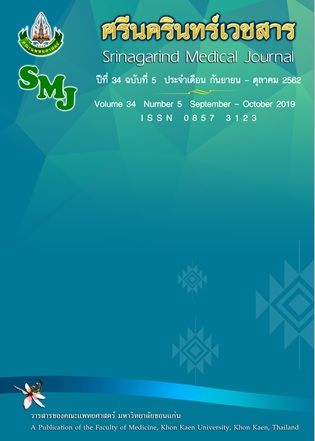Situation of Questionnaire Used in Hand Function Assessment by Physical Therapist
Keywords:
Questionnaire, Assessment, Hand, Physical Therapist, แบบสอบถาม, การประเมิน, มือ, นักกายภาพบำบัดAbstract
สถานการณ์ของแบบสอบถามที่ใช้ในการประเมินการทำงานของมือโดยนักกายภาพบำบัด
สุภารัตน์ สุขโท1,สัมมนา มูลสาร2, ศักดิ์สิทธิ์ ศรีภา2, แสวง วัชระธนกิจ2*
1นักศึกษาปริญญาเอกคณะเภสัชศาสตร์ มหาวิทยาลัยอุบลราชธานี, อาจารย์คณะแพทย์แผนไทยและแพทย์ทางเลือก มหาวิทยาลัยราชภัฏอุบลราชธานี
2กลุ่มวิชาเภสัชกรรมปฏิบัติ คณะเภสัชศาสตร์ มหาวิทยาลัยอุบลราชธานี
หลักการและวัตถุประสงค์ : พยาธิสภาพที่มือเป็นอุปสรรคกับการทำงานและส่งผลกระทบต่อการทำกิจวัตรประจำวัน ซึ่งนักกายภาพบำบัดมีบทบาทเป็นผู้ตรวจประเมิน วางแผนและให้การรักษา แต่ในปัจจุบันยังไม่มีมาตรฐานของการประเมินการทำงานของมือที่เป็นรูปแบบเดียวกันในการให้บริการ ดังนั้นการศึกษานี้จึงมีวัตถุประสงค์เพื่อสำรวจสถานการณ์ของแบบสอบถามที่ใช้ในการประเมินการทำงานของมือโดยนักกายภาพบำบัด
วิธีการศึกษา : เป็นการศึกษาเชิงสำรวจแบบภาคตัดขวาง กลุ่มตัวอย่าง คือ นักกายภาพบำบัดที่ดูแลรักษาผู้ป่วยและมีประสบการณ์การทำงานในโรงพยาบาลของรัฐอย่างน้อย 1 ปี จำนวน 336 ราย ที่ได้จากการสุ่มกลุ่มตัวอย่างแบบหลายขั้น ผู้วิจัยส่งจดหมายขอความอนุเคราะห์ตอบแบบสอบถามทางไปรษณีย์ให้กับกลุ่มตัวอย่าง โดยกลุ่มตัวอย่างสามารถเลือกตอบแบบสอบถามแบบออนไลน์ หรือตอบแบบสอบถามกระดาษพร้อมส่งแบบสอบถามกลับทางไปรษณีย์ โดยกำหนดระยะเวลาตอบกลับภายใน 2 สัปดาห์ แบบสอบถามผ่านการประเมินเนื้อหาโดยผู้ทรงคุณวุฒิจำนวน 3 คน มีทั้งหมด 2 ตอน คือ 1) ข้อมูลทั่วไปของผู้ตอบแบบสอบถาม 2) แบบประเมินหรือเครื่องมือในการประเมินบริเวณมือของผู้ป่วย
ผลการศึกษา : จากแบบสอบถามที่ส่งออกจำนวน 336 ฉบับ มีผู้ตอบแบบสอบถามที่สมบูรณ์จำนวน 115 ฉบับ (ร้อยละ 34.23) สำหรับโรคที่ผู้ป่วยระบบกระดูกและกล้ามเนื้อบริเวณมือมารับการรักษาบ่อยที่สุด คือโรคการกดทับเส้นประสาทบริเวณข้อมือ ซึ่งการประเมินหรือเครื่องมือที่ใช้มากที่สุด คือโกนิโอมิเตอร์ (ร้อยละ 38.30) มาตรวัดระดับความเจ็บปวด (ร้อยละ 30.40) และการประเมินกำลังกล้ามเนื้อ (ร้อยละ 27.00) โรคระบบประสาทที่มีพยาธิสภาพบริเวณมือที่มารับการรักษาบ่อยที่สุด คือโรคหลอดเลือดสมองขาดเลือด แบบประเมินหรือเครื่องมือที่ใช้มากที่สุด คือ การตรวจการทำงานของมือ (ร้อยละ 27.80) การประเมินกำลังกล้ามเนื้อ (ร้อยละ 24.30) และแบบประเมิน The Barthel activity of daily living index (ร้อยละ 17.40)
สรุป : รูปแบบในการตรวจประเมินการทำงานของมือโดยนักกายภาพบำบัดที่ความหลากหลาย จึงควรกำหนดเครื่องมือที่เป็นมาตรฐานในการประเมินการทำงานของมือเพื่อส่งเสริมการให้การรักษาผู้ป่วยโดยช่วยในการส่งต่อข้อมูลที่เป็นมาตรฐานเดียวกัน
Background and Objective: The pathological conditions of hand are barriers to work and affect the daily activities. Physical therapists are responsible for assessment, planning treatment goals and providing treatment to the patients. But, there is no standard of hand function assessment to used in health service.
Methods: This was a cross-sectional survey research. The samples were 336 physical therapists who has at least 1 year working experiences in government hospitals and were selected by multi-stage sampling. The researchers sent the letters of request to the sample group to respond to the questionnaire by mail. They can choose answering either online or paper-based questionnaire and sent it back by mail within 2 weeks due date. The questionnaire, validated by 3 experts for content validity, has 2 parts: 1) characteristics of respondents, and 2) questionnaire or instrument for hand area assessment of patient.
Results: Of 366 questionnaires sent, 155 (34.23%) with completed responses were returned. The most common musculoskeletal disease at hand was Carpal tunnel syndrome. The top 3 frequently used assessment tools were goniometer (38.30%), pain scale (30.40%) and muscle manual testing (27.00%). The most common neurological disease at hand found was stroke and the top 3 frequently used assessment tools were hand function test (27.80%), muscle manual testing (24.30%), and the Barthel activity of daily living index questionnaire (17.40%).
Conclusion: Various assessment tools for hand function were used by physical therapists. Therefore, standard tools for hand function assessment should be determined to support quality patient care with shared standard information.
References
Janwantanakul P. Prevalence of self-reported musculoskeletal symptoms among office workers. Occup Med (Lond) 2008; 6: 436-8.
Guo H. Prevalence of musculoskeletal disorder among workers in taiwan a nationwide study. JOH 2004; 46: 26-36.
Picavet H. Musculoskeletal pain in the Netherlands: Prevalences, consequences and risk groups, the DMC(3)-study. Pain 2003; 1-2: 167-78.
Salik Y, Ozcan A. Work-related musculoskeletal disorders: A survey of physical therapists in Izmir-Turkey. BMC Musculoskeletal Disorders 2004; 5: 27.
West D, Gardner D. Occupational injuries of physiotherapists in North and Central Queensland. Australian Journal of Physiotherapy 2001; 47: 179-86.
Macdonald B, Cockerell O, Sander J, Sheorvon S. The incidence and lifetime prevalence of neurological disorders in a prospective community-based study in the UK. Brain 2000; 123: 665-76.
Arwert H, Schut S, Boiten J, Vliet Vlieland T, Meesters J. Patient reported outcomes of hand function three years after stroke. Top Stroke Rehabil 2018; 25: 13-9.
ประวิตร เจนวรรธนะกุล. โรคทางระบบกระดูกและกล้ามเนื้อในผู้ที่ทำงานสำนักงาน ความชุกและอุบัติการณ์ของโรคทางระบบกระดูกและกล้ามเนื้อในผู้ที่ทำงานในสำนักงาน. กรุงเทพฯ:ก.พล(1966), 2558.
Lee k, Jung M. Ergonomic Evaluation of Biomechanical Hand Function. Saf Health Work 2015; 6: 9-17.
ราชกิจจานุเบกษา. มาตรฐานบริการกายภาพบำบัด. 2553 [cited 6 กุมภาพันธ์ 2562]. Available from http://pt.or.th/file_attach/09Aug201210-AttachFile1344509470.PDF.
Dale A, Adamson C, Rempel D, Gerr F, Hegmann K, Silverstein B, et al. Prevalence and incidence of carpal tunnel syndrome in US working populations: pooled analysis of six prospective studies. J Work Environ Health 2013; 5: 495-505.
Thinen N, Tsukimoto D, Tsukisumoto G. Functional evaluation of hemiplegic patients post stroke using the Disabilities of the Arm, Shoulder and Hand - DASH questionnaire. Acta Fisiatr 2016; 1: 25-9.


